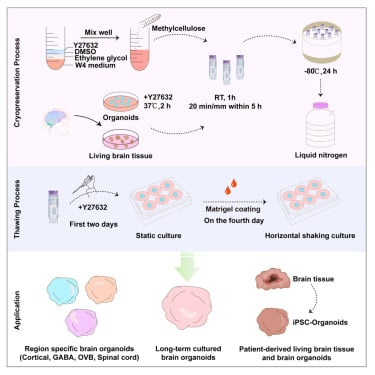⇧ (VIDEO) You might also like this affiliate content
Researchers have developed MEDY, a new chemical cocktail that allows brain tissue to be frozen and thawed without damage. After being pre-soaked in the solution and then cryogenically frozen in liquid nitrogen, the cells returned to normal function up to 18 months after freezing. This preservation technique should significantly improve access to quality brain samples for biomedical research.
Organoid cultivation represents one of the greatest advances in biomedical research in recent years. These clusters of cells enabled the reproduction of most brain diseases, which enabled the study of their biomolecular mechanisms, as well as the development of new drugs. However, their availability is considerably limited due to the time and high costs required for their cultivation, as well as problems related to their preservation.
Indeed, research has shown that no matter how quickly brain tissue is frozen, the transition from freezing to thawing still causes tissue damage. Preservation of brain organoids with specific pathological characteristics by freezing is extremely difficult, because very few neurons remain functional after thawing. As a result, much of the research is done immediately after the tissue samples are obtained.
On the other hand, cryogenic technologies now enable efficient preservation of embryonic stem cells, gametes and embryos. After cryopreservation and thawing, bovine sperm can, for example, be fertilized
in vitro. After transplantation into a female, the resulting embryos develop successfully.
However, cryogenic brain organoids with complex cytoarchitecture face significant challenges. Indeed, techniques used for two-dimensional arrays of cells and non-neural organoids are not suitable for neural and living tissues of the human brain in general (due to their highly complex architecture).
Researchers at Fudan University, China, have developed a way to solve these problems by pre-soaking brain organoids in a special solution before cryogenically freezing them. The new technique enabled the preservation of large and diverse cortical clusters that retained their structural integrity and function, even after a surprisingly long cryogenic time.

Graphic summary of the study. © Weiwei Xue et al.
Continued growth for 150 days
To develop their preservation solution, Fudan University researchers tested different chemical combinations. The ingredients were selected according to their ability to maintain the morphological integrity of the organoid after thawing, to reduce the loss of nerve cells and to promote the growth of neurites (projections of the cell body of a neuron: either axon or dendrite). These ingredients include methylcellulose, ethylene glycol, polyvinylpyrrolidone (PVP), trehalose, glucose, sucrose, and proline.
Brain organoids were grown for 21 days from human embryonic stem cells. This growth time allows them to differentiate into neural progenitor cells and functional neurons. After being immersed in a series of combinations of preservation solutions, the resulting organoids were cryogenically stored in liquid nitrogen for 24 hours and then quickly dissolved in warm water. After numerous attempts and freeze-thaw cycles, experts found that the most effective combination is ethylene glycol, methylcellulose, DMSO and Y27632 (MEDY).
The second part of the study consisted of evaluating the effectiveness of the MEDY solution on different types of organoids specific to different regions of the central nervous system, including the dorsal and ventral forebrain, spinal cord, and optic vesicles (OVB). The age of the organoids (from 4 weeks to 3 months) and the length of time they were pre-soaked in the solution also varied. The technique was further tested on organoids obtained from patients with epilepsy.
The researchers found that after each cycle of cryogenic thawing, the organoids still displayed similar functions to those that had never been frozen. The cell clusters continued to function properly, even after thawing after 18 months, and continued to grow for approximately 150 days.
Furthermore, organoids obtained from epilepsy patients still had the same pathological characteristics after thawing. Transcriptomic analyzes showed that the solution preserved synaptic functions and inhibited the endoplasmic reticulum-mediated apoptosis pathway.
The research team believes the technique could be extended to larger brain samples, which could potentially be useful for research in the field. ” MEDY will enable reliable large-scale storage of various neural organoids and living brain tissues and facilitate large-scale research, medical applications and drug development », the researchers conclude in their report, published in detail in the journal
Cell report methods.

